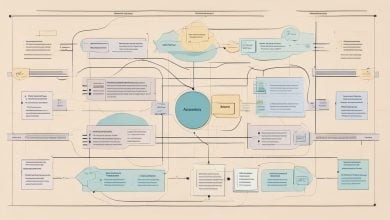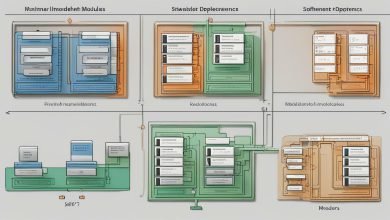
When it comes to software development, achieving rapid object cloning is an essential part of the process. One design pattern that plays a vital role in this is the prototype pattern. The prototype pattern allows for efficient cloning of objects, reducing development time and enhancing maintainability. In this section, we will explore the concept of the prototype pattern and its significance in rapid object cloning.
Key Takeaways:
- The prototype pattern is an important design pattern in rapid object cloning.
- It allows for efficient cloning of objects, reducing development time and enhancing maintainability.
- The prototype pattern is a crucial part of software design.
Understanding the Prototype Pattern
In object-oriented programming, a design pattern is a reusable solution to a commonly occurring problem. One such pattern is the prototype pattern, which involves creating an object as a prototype and then cloning it to create new objects. This pattern enables developers to create new objects quickly and efficiently, without the need to write code from scratch each time.
At its core, the prototype pattern involves creating an abstract class that serves as the prototype for other objects. The prototype object contains the basic structure and behavior of the objects to be created. The new objects are then created by cloning the prototype object and modifying it as needed.
The prototype pattern also has relevance to other programming patterns, such as the factory pattern. In fact, the prototype pattern can be seen as a form of the factory pattern, since it involves creating new objects in a similar way.
The main advantage of the prototype pattern is that it enables rapid object cloning. In contrast to other object creation techniques, such as class instantiation, the prototype pattern allows for the creation of new objects without invoking constructors or initializing fields. This results in faster and more efficient object creation, which can be especially useful in large-scale software development projects.
Overall, the prototype pattern is a powerful tool in object-oriented programming that allows for rapid object cloning and efficient coding practices. By understanding the basics of this pattern and its relevance to other programming patterns, developers can utilize it to streamline their code and enhance their coding excellence.
Advantages of Rapid Object Cloning
Rapid object cloning is a software development pattern that offers a range of advantages for developers. By utilizing the prototype pattern, developers can achieve increased productivity, reduced development time, and enhanced maintainability.
The prototype pattern allows developers to clone existing objects quickly, avoiding time-consuming and error-prone manual coding. Rapid object cloning enables developers to create new objects that share the same properties as the original objects while avoiding duplicating code. This saves time and effort, enabling developers to focus on adding new features to their software applications.
The benefits of rapid object cloning are particularly valuable when dealing with data-heavy applications, such as in game development or financial applications. In such cases, rapid object cloning can significantly reduce development time and enable developers to deliver more complex and sophisticated software applications.
Implementing the prototype pattern in software design requires careful consideration of the underlying architecture and coding practices. To achieve the benefits of rapid object cloning, developers must ensure that their software architecture facilitates effective object cloning and reuse. Additionally, employing best coding practices is essential to maintain the quality of the codebase.
Overall, the prototype pattern is an essential part of software design for achieving rapid object cloning. Its benefits in terms of speed, efficiency, and maintainability make it a valuable addition to any software development toolkit. By utilizing the prototype pattern effectively, developers can deliver high-quality software applications in a shorter time frame and with greater ease.
Implementing the Prototype Pattern
Implementing the prototype pattern in software architecture requires a thorough understanding of its design and coding principles. The primary goal is to create a prototype object and use it to create new objects by cloning it. The following steps outline a typical implementation process:
- Create a prototype object that will act as a model for all future objects.
- Define a clone method that will make a copy of the prototype object.
- Create new objects by calling the clone method on the prototype object.
- Customize cloned objects if necessary.
It is important to note that implementing the prototype pattern involves more than just coding. It requires careful consideration of software architecture, design patterns, and object cloning. Here are some best practices to follow:
- Ensure that the prototype object is immutable to prevent accidental changes during cloning.
- Use a centralized registry to store and manage prototype objects.
- Avoid using the new operator to create objects; instead, rely on cloning the prototype object.
- Keep the clone method simple and free from dependencies.
By adhering to these best practices, developers can create an efficient and effective implementation of the prototype pattern. This will result in a software architecture that is easy to maintain, enhances code quality, and promotes rapid object cloning.
Use Cases of the Prototype Pattern
The prototype pattern is a versatile design pattern that finds application in various scenarios across different domains. Below are some common use cases where the prototype pattern can be leveraged to achieve rapid object cloning:
Software development
In software development, the prototype pattern can be used to create new objects with minimal overhead. This approach is especially useful in situations where creating new objects from scratch can be a costly process. By using the prototype pattern, developers can create copies of existing objects with different properties, allowing for faster development and testing.
Game development
The prototype pattern is also prevalent in game development. Game engines use the prototype pattern to create instances of objects at runtime, allowing for more efficient resource management. By creating a prototype object and cloning it, game engines can reduce the number of objects created and increase performance.
Other industries
The prototype pattern is not limited to software and game development. Other industries such as automotive, aerospace, and manufacturing have also adopted the prototype pattern to streamline their processes. For instance, in the automotive industry, the prototype pattern is used to create new car designs by modifying existing ones, reducing the time and cost of developing new models.
Overall, the prototype pattern is a powerful design pattern that offers significant benefits in terms of speed, efficiency, and maintainability. Its versatility makes it an essential tool in the toolkit of any developer looking to achieve rapid object cloning and seamless software design.
Challenges and Considerations
Implementing the prototype pattern in software development can present various challenges and considerations that developers must be aware of to ensure optimal results for rapid object cloning.
Rapid object cloning: The prototype pattern can significantly enhance the speed and efficiency of object cloning, but developers must be careful not to sacrifice quality for speed. Rushing through the process can result in errors and bugs that may require additional time and effort to fix.
Software development pattern: While the prototype pattern is a proven software development pattern, it may not always be the best solution for every project. Developers must weigh the advantages and disadvantages of the pattern against project requirements and constraints before implementing it.
Software design: The prototype pattern can impact software design decisions, such as code structure and architecture. Developers must consider the broader implications of the pattern on the software design and ensure that it aligns with the overall project goals and objectives.
Testing: Proper testing is crucial when implementing the prototype pattern for rapid object cloning to ensure that the cloned objects function as intended. Developers must design comprehensive and effective testing protocols to detect and address any errors or issues that may arise.
Trade-offs: The prototype pattern offers many benefits, but it also has trade-offs. For example, using the pattern may increase the memory usage of the software, which can impact performance. Developers must carefully consider the trade-offs involved and determine whether the benefits outweigh the costs for the specific project.
Conclusion
Overall, the prototype pattern is a valuable tool for achieving rapid object cloning in software development. However, developers must be aware of the challenges and considerations involved to implement the pattern effectively and avoid potential pitfalls. By incorporating the prototype pattern into their software development practices, developers can achieve enhanced coding excellence and seamless software design while balancing the trade-offs and considerations involved.
Future Trends and Innovations
The prototype pattern has been a cornerstone of rapid object cloning for many years. However, as software development continues to evolve, new trends and innovations emerge, and the prototype pattern is no exception.
Integrating AI and Machine Learning
One of the most exciting innovations in software development is the integration of AI and machine learning. By leveraging these technologies, developers can create more intelligent and efficient software architectures that can adapt to changing conditions and user behavior. The prototype pattern can play a crucial role in this regard, enabling developers to rapidly clone objects and test different iterations, thereby facilitating the development of more robust and sophisticated AI-powered software.
Blockchain and Decentralized Software
Another emerging trend in software development is the rise of blockchain and decentralized software. These technologies offer new possibilities for security, privacy, and data ownership, but they also present unique challenges for object cloning and software architecture. The prototype pattern can help developers address some of these challenges by providing a streamlined approach to cloning objects across decentralized networks and ensuring consistency and reliability in data storage and transmission.
Scaling and Distributed Systems
As software systems become more complex and distributed, scaling and performance optimization become increasingly crucial. The prototype pattern can help developers address these challenges by enabling rapid cloning of objects across multiple servers and nodes, thereby facilitating faster and more efficient communication and computation. Additionally, the prototype pattern can help ensure consistency and reliability in data storage and communication, reducing the risk of errors and system failures.
Overall, the future of rapid object cloning and software architecture looks bright, with many exciting new trends and innovations on the horizon. By leveraging the power of the prototype pattern and other cutting-edge technologies, developers can create more intelligent, efficient, and adaptable software systems that meet the evolving needs and demands of users and businesses alike.
Conclusion
The prototype pattern is a crucial element in achieving rapid object cloning in software development. It offers several advantages, such as increased productivity, reduced development time, and enhanced maintainability, which make it an indispensable software development pattern.
By implementing the prototype pattern effectively, developers can revolutionize the way object cloning is done, leading to enhanced coding excellence and seamless software design. Its relevance to other programming patterns and its versatility in different domains make it a valuable tool in software architecture.
Future Trends and Innovations
As the field of software development continues to evolve, the prototype pattern is expected to undergo new trends and innovations. New advancements and research areas could shape the future of rapid object cloning and the prototype pattern. Therefore, it is crucial for developers to stay up-to-date on these developments and utilize them to their full potential.
In conclusion, the prototype pattern remains an essential software development pattern for achieving rapid object cloning. Its benefits make it a highly valuable tool in software architecture, and effective implementation can lead to enhanced coding excellence and seamless software design.
FAQ
Q: What is the prototype pattern?
A: The prototype pattern is a design pattern in object-oriented programming that allows for the creation of new objects by copying existing objects. It provides a way to create object instances without the need to explicitly define their classes and instantiate them using constructors.
Q: How does the prototype pattern facilitate rapid object cloning?
A: The prototype pattern facilitates rapid object cloning by providing a mechanism to clone existing objects. Instead of creating new objects from scratch, developers can simply clone a prototype object and customize it as needed. This saves time and effort in creating and initializing new objects, resulting in faster and more efficient object cloning.
Q: What are the advantages of rapid object cloning?
A: Rapid object cloning offers several advantages in software development. It increases productivity by reducing the time and effort required to create new objects. It also enhances maintainability as changes made to the prototype object automatically apply to all cloned objects. Additionally, rapid object cloning reduces development time, allowing for faster iteration and delivery of software projects.
Q: How can the prototype pattern be implemented?
A: The prototype pattern can be implemented by creating a prototype object and defining a clone method that copies the object’s state. This prototype object can then be cloned whenever a new object instance is needed. Developers can customize the cloned objects by modifying their state or behavior as required.
Q: In what use cases can the prototype pattern be leveraged?
A: The prototype pattern can be leveraged in various scenarios across different domains. In software development, it can be used to create copies of complex objects, such as database connections or configuration settings. In game development, it can be used to create multiple instances of game characters or entities. The versatility of the prototype pattern makes it applicable in many situations that require rapid object cloning.
Q: What challenges and considerations should be taken into account when implementing the prototype pattern?
A: While the prototype pattern offers significant benefits, there are challenges to consider during its implementation. One challenge is maintaining the integrity of cloned objects and ensuring that changes made to one instance do not affect others. It is also important to carefully manage the state of the prototype object to avoid unintended side effects. Developers should be mindful of these considerations to ensure the effective and efficient use of the prototype pattern.
Q: What does the future hold for the prototype pattern and rapid object cloning?
A: As software development continues to evolve, the prototype pattern and rapid object cloning are likely to adapt to new technologies and demands. Future advancements may include improved cloning techniques, enhanced support for dynamic object creation, and integration with emerging software architectures. Research and innovation in this area will shape the future of the prototype pattern and its role in achieving rapid object cloning.








